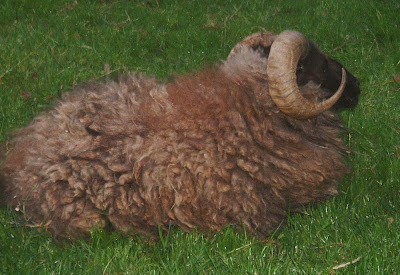Once your fleece has been washed, you will need to decide how you will prepare the fibers for spinning.
For those non-spinners who are reading, keep in mind that the goal of fiber preparation is to “arrange” all of the individual fibers so that they can be spun into yarn.
First, it must be said that Mother Nature has done a splendid job of arranging wool for spinning. All you have to do is part the fleece when it is still on the sheep. You will see that all of the fibers in the fleece are naturally lined up parallel to each other. For example here’s a picture of a brown (noisette) fleece :

and Margot’s black fleece :

See how each lock contains lots of nicely arranged fiber.
Since the objective of fiber prep is to organize the fibers so that they are parallel to each other, it is to our advantage to work with nature, or at the very least not to mess things up and make more work for ourselves than necessary! This is why I’ve tried to stress the importance of keeping the lock formation of the fleece during washing and drying : it makes later processing much, much easier!
Essentially, there are 3 basic methods of preparing fiber for spinning – spinning from the lock, carding, and combing – with each method presenting a couple of variations. As with anything, there is no right or wrong way of preparing fiber : it depends on your desired results, the particular fleece you are dealing with, the equipment that you have on hand, your skill level, and your personal preference. Of course each method has some draw backs as well.
Today, I’d like to talk about spinning directly from the lock ...
First, this is by far the easiest, least expensive and most straightforward method of fiber preparation.
The advantages of this method should be obvious. The disadvantages depend on the skill of the spinner, the quality of the fleece and the yarn desired. It does require a high quality fleece to begin with. Additionally it requires a certain amount of spinning skill. Finally, the finished yarn may or may not be what you were hoping for.
There are two variations of spinning from the lock : one using no equipment at all, the other using a flicker brush/carder.
First you begin with a lock of wool. If you want to spin directly from the lock, all you have to do is gently open up the lock with your fingers and spin away.
OR. ... you can use a flicker brush/carder to open up the lock.
Hold the butt end firmly then “brush” the tip end.
Now turn the lock around and hold the tip end while you brush the butt end. Then spin.
Note that the objective of both of these methods is to keep the fibers straight and parallel. Additionally the advantage of using a flicker brush is that you are opening up the ends, eliminating any second cuts and short fiber, and removing any bits of “stray” vegetable matter that might be lingering in the lock.
 RhumRaisin : Fleece, flicker carding
RhumRaisin : Fleece, flicker cardingTo be quite honest about it there are few draw backs to this method.
BUT you do have to start with a clean fleece with good lock structure.
This is one of my favorite methods for preparing fiber : particularly because it produces little if any wasted fiber. I haven’t decided yet, but I just may be using the flicker brush method on at least one or two of my fleeces.
In the mean time, check out these two videos on preparing fiber using a flicker brush.
Preparing wool locks from "In Sheep's Clothing" Short video on using the flicker brush from "The Joy of HandSpinning"

































